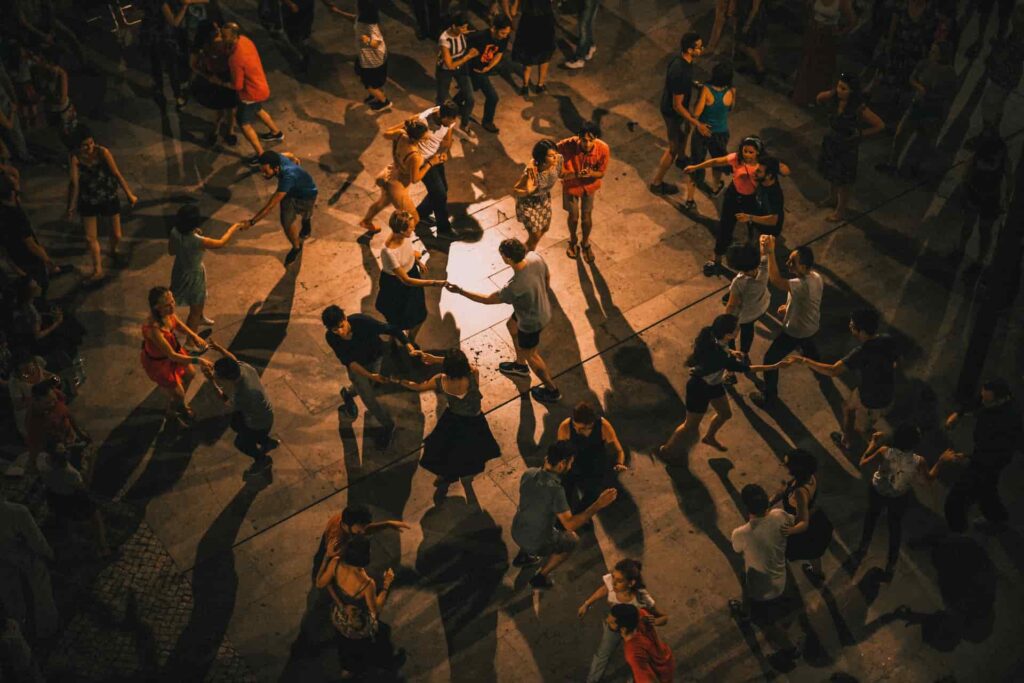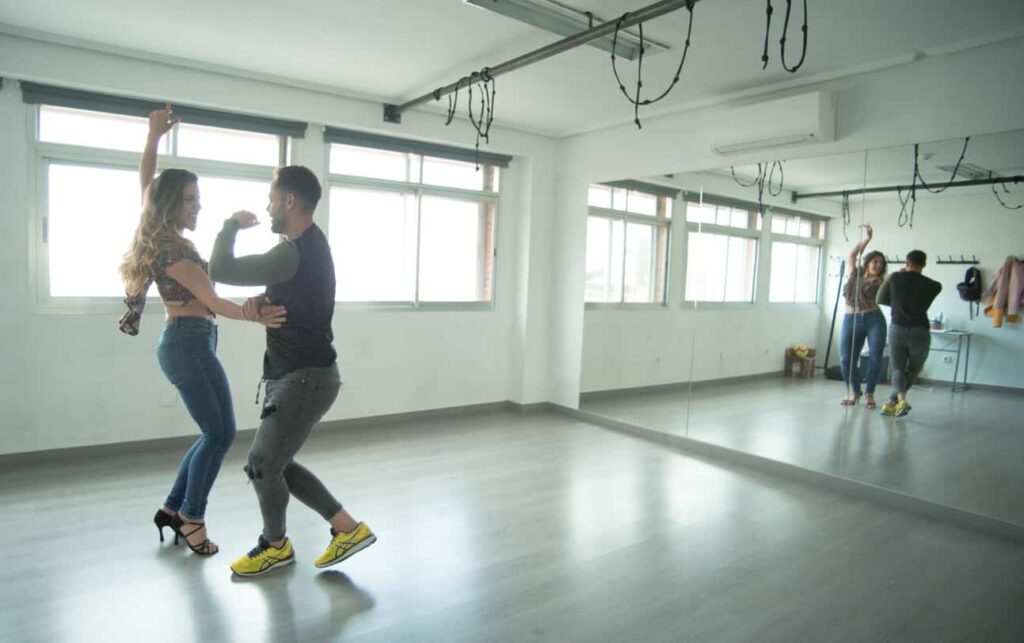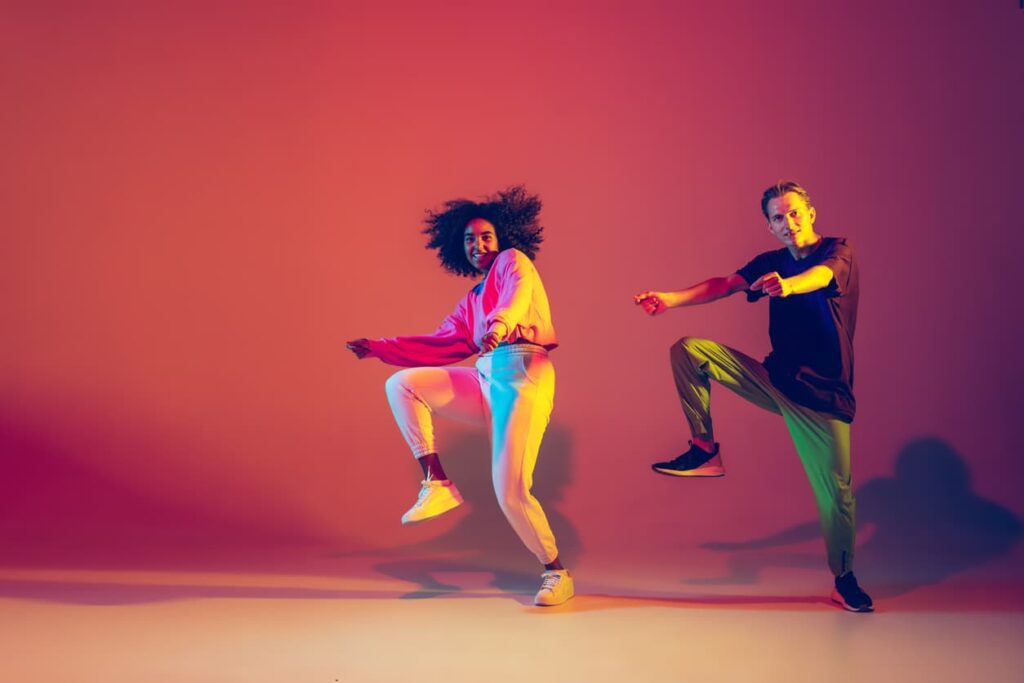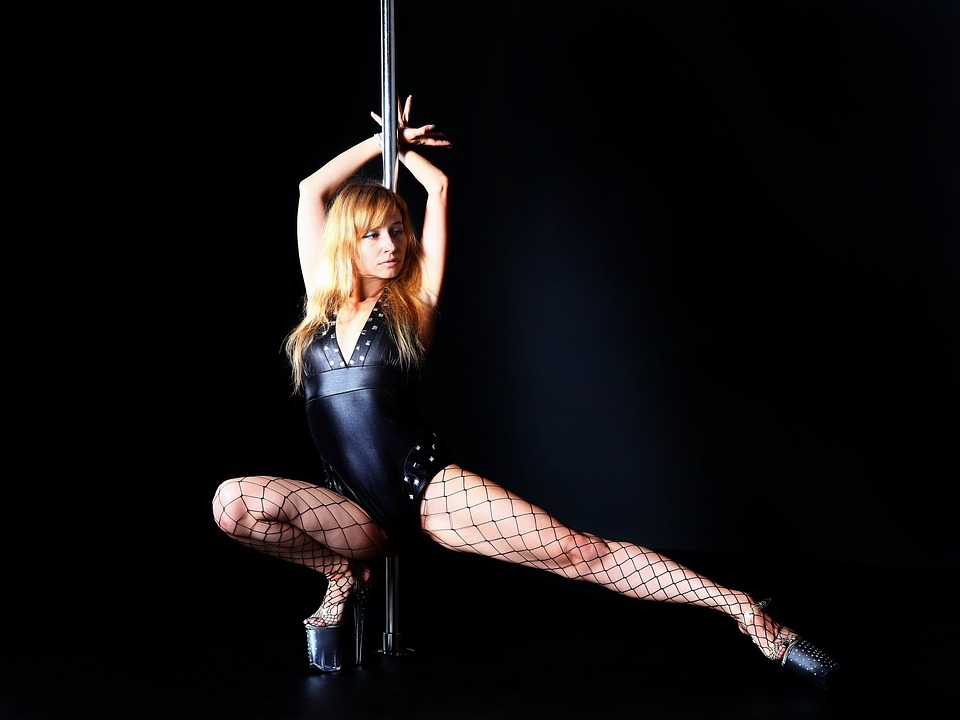
Summary
Square dance: discover an authentic dance
Want to get moving, meet new people and discover authentic dance? Square dancing is a dynamic activity that combines tradition and fun, ideal for unwinding after work. Available in France, this dance brings together enthusiasts from all walks of life.
Whether you're a beginner or an experienced dancer, square dance is suitable for all levels. It's the perfect opportunity to have fun while learning original choreography guided by a caller.
Summary
Introduction to square dance
Definition of square dance
Square dancing is a traditional American group dance. It is characterised by choreographic figures called "Calls, guided by a caller, a person who announces the movements to be made. Each group is made up of four couples forming a square, hence the name of the dance. Using synchronised movements and specific calls, the dancers create dynamic patterns and sequences. Square dance is not just a dance, it's a collective experience that emphasises coordination, listening and, above all, the pleasure of dancing together.
Origin and history of this American folk dance
Square dance has its roots in 17th-century European ballroom dances such as quadrilles and cotillions. During the colonisation of the AmericasThese dances have evolved through contact with different cultures and have been enriched by new styles and influences. In the 19th centurySquare dancing became a common practice in rural American communities, marking the beginning of its popularity across the country. Over time, it has adapted, incorporating modern elements while retaining its folkloric essence. Today, this dance is a symbol of conviviality and tradition in the United States, and it continues to bring together enthusiasts of all ages around the world.

The fundamentals of square dance
Square formation: 4 couples, 8 dancers
THE square dance is distinguished by its square formation, in which four couples are positioned symmetrically, forming the sides of the square. Each pair occupies a corner and is assigned a number from 1 to 4, making it easy to find the right direction. caller. This structure is essentialIt allows the dancers to perform complex figures, moving from one corner to another while maintaining the symmetry of the group. The roles of each dancer are well definedThis ensures cohesion and fluidity of movement.
The role of the caller and the importance of calls
THE caller is the central element of square dance. He guides the dancersby giving voice instructions, known as "calls", which indicate the movements to be made in real time. These calls are often set to the music and require the dancers to react quickly. The caller also plays a creative role by adapting the choreography to the level and energy of the group, making each dance unique. Without it, square dance would lose its essence of spontaneity and collective coordination.
Basic movements and specific terminology
Square dance is based on a specific vocabulary of basic movements, such as the do-si-do, THE walkor the swing. These terms refer to specific sequencesThese dances are often simple to perform, but require good listening skills and coordination with your partner and the rest of the group. Over time, the dancers learn new moves, enriching their repertoire and making the dance more dynamic and varied. Mastering these fundamentals is crucial if you want to play a full part in square dance sessions and festivals, whether in France or elsewhere.
The different styles of square dance
Traditional square dance
THE traditional square dance is the original version, often practised in rural America. It is based on simple figures handed down from generation to generation. The calls are standardised, and the accompanying music is generally folk or country, played on instruments such as the banjo and the fiddle. This style emphasises conviviality and traditionIt creates a warm, authentic atmosphere. Dancers appreciate its accessible nature, allowing beginners to integrate quickly into the group while having fun.
Modern western square dance
THE square dance modern western is an evolution of the traditional style that emerged in the mid-20th century. This style is characterised by more complex choreography and a greater variety of styles. callswhich makes it more dynamic and demanding. The dancers often wear outfits inspired by the western style.The music has also opened up to more contemporary genres, sometimes incorporating pop or jazz elements. Modern Western square dance attracts those looking for a technical challenge, while retaining the social and festive aspect of the dance.
Regional variants
As well as traditional and modern styles, square dance comes in a number of different forms. regional variationseach with its own local touch. For example, in the southern United States, the 'Appalachian' style incorporates influences from clogging dance, while the "New England contra dance uses similar formations to square dance but with different sequences. These variants enrich the dancers' experience, giving them the opportunity to explore different cultures and traditions while practising their shared passion.
The social and community aspect of square dance
The spirit of conviviality and sharing
THE square dance is not just a dance, it's above all a social experience. It encourages interaction and exchange between participants, creating a spirit of conviviality and sharing. The dancers form a circle of trustIt's an activity that breaks the ice and strengthens bonds. It's an activity that breaks the ice and strengthens bonds, as each dance requires the cooperation of all the members of the group. Beyond danceIt's a chance to get together, laugh and have a good time as a community.
Square dance clubs and how they work
THE square dance clubs play an essential role in keeping this dance alive. They bring together enthusiasts who meet regularly to practise, learn new techniques and share their passion for dance. callsand share their common passion. Each club is run by a caller who guides the sessions and trains beginners. These clubs also organise social events such as themed evenings and friendly competitions, reinforcing the feeling of belonging to the group. New arrivals are always welcomed, because inclusion and sharing are at the heart of this activity.
Square dance events and festivals
THE square dance events and festivals are high points for the community. They bring together dancers from all backgrounds, allowing them to discover different styles and meet new people. Some festivals even run over several days, offering workshops, competitions and lively evenings. These events are the perfect opportunity to celebrate square dance culture while strengthening the bonds between participants. For manyIt's a privileged moment where dance becomes a pretext for celebration and the discovery of other enthusiasts.
Square dancing in France
Square dance clubs and associations in France
In France, the square dance is growing in popularity thanks to the many clubs and associations dedicated to the sport. These structures are spread across the country, bringing together enthusiasts who meet regularly to dance and train. The clubs welcome dancers of all levelsFrom beginners to experts, they offer courses to suit everyone. Their aim? To share their passion for square dance and promote this American folk dance to a curious and enthusiastic French public.
Courses and workshops for beginners
Square dance clubs in France often offer courses and workshops specially designed for beginners. These sessions provide an opportunity to learn the basics: square formation, the main techniques, etc. callsand simple figures. Teachers and callers guide new dancers step by step, creating a friendly and encouraging environment. These classes are also an opportunity to meet new people, get to know the warm atmosphere of square dance and progress at your own pace. For young urban executives, it's a fun and social way to discover a new activity.
Major square dance events in France
Several key events The square dance calendar in France is punctuated by festivals, competitions and themed evenings organised by clubs. These get-togethers allow enthusiasts to get together and share their passion. They are also an opportunity to discover callers and try their hand at a variety of styles, from traditional to modern western. These events add a festive dimension and reinforce the community aspect of the dance, while offering a real immersion in square dance culture.
Square dancing for young urban executives
The benefits of square dance for physical and mental health
THE square dance offers many advantages for young urban executives looking for an activity that is both physical and entertaining. Dancing involves the whole body, building muscle, cardio and endurance. It's an excellent way to keep fit while having fun. But the benefits don't stop there: square dance also stimulates the mind by developing memory, concentration and responsiveness thanks to the calls of caller. It's a real antidote to stressIt's a great way to relax and disconnect from everyday life while reconnecting with others.
Square dancing as a team-building activity
For companies looking for innovative team buildingsquare dance is an ideal opportunity. This activity encourages collaboration, communication and team cohesion. By learning to follow calls and coordinate their movements, participants develop essential listening and cooperation skills. It's a fun and friendly activity which helps to strengthen links between colleagues, break the ice and create a team spirit in a relaxed and happy atmosphere. A perfect solution for combining fun and professional development.
How to incorporate square dance into an active lifestyle
Square dance can be easily integrated into the daily lives of young working people thanks to its flexibility. Whether in the evenings, at weekends or in weekly classes, there are plenty of options for practising without timetable constraints. Clubs and events offer a variety of slotsIt's a great way to fit in with busy schedules. What's more, by combining the social and sporting aspects, square dancing becomes a pleasant way of maintaining regular physical activity, while creating links with other young executives who share the same interests. It's the perfect way to combine a balanced lifestyle with personal fulfilment.
Start square dancing: practical advice
Appropriate clothing
To get started in square danceIt's important to choose comfortable, appropriate clothing. Although western style is often associated with this dance, it is not obligatory to dress as a cowboy or cowgirl. Choose lightweight clothing that allow great freedom of movement. For shoes, opt for flexible models with a sole that glides slightly, to make it easier to turn and move around quickly. The most important thing is to feel comfortable so that you can enjoy the experience to the full and keep up with the latest developments. calls in complete freedom.
The first tricks to master
When starting out in square dance, it is essential to familiarise yourself with the basic figuressuch as do-si-do, THE walkor the German left. These movements form the basis of the dance and enable you to integrate quickly into a group. It is advisable to repeat these figures during the first sessions to master them and gain confidence. Progressively, other more complex sequences will be added, but the learning process is always step-by-step, under the guidance of the caller. With a little practice, these movements become automatic, making the dance experience even more fluid and enjoyable.
How to find a partner and integrate into the community
Square dancing is practised in groups, but you don't need a partner to start. Square dance clubs in France are very welcoming, and it is common for dancers to change partners during the sessions. This encourages newcomers to meet new people and integrate quickly. For those who want to meet other enthusiasts, the events and workshops organised by the clubs are ideal opportunities. The friendly spirit of the community makes it easy to forge links and quickly feel at ease, even as a beginner.
Square dance and popular culture
The square dance in country and folk music
THE square dance is closely linked to American country and folk music, which is its traditional musical backdrop. Emblematic instruments such as the fiddle, guitar and banjo set the rhythm for the dancers' steps and create a festive atmosphere. Lots of country music contain references to square dance, reinforcing this cultural connection. In the evenings, the link between dance and music creates an authentic and warm atmosphere, immersing participants in the heart of traditional America. It's an artistic fusion that allows dancers to feel the very spirit of this culture.
Representations of square dance in the media and cinema
Square dancing has also found its way into the media and cinema, particularly in American films and series that feature rural culture or traditional festivals. From classic westerns to modern romantic comedies, this dance is often seen as a symbol of conviviality and tradition. It is used to represent the values of unity and community, whether in a village fete scene or a family gathering. These representations help to reinforce the image of square dancing as an activity rooted in American history and identity.
The influence of square dance on other forms of dance
Square dance is not confined to its own practice; it has also influenced many other forms of dance, particularly in the field of partner and line dancing. The choreography of line dance or the country swing take up elements and calls inspired by square dance. This influence also extends to contemporary dances, which incorporate similar movements or are inspired by them to create new variations. Square dance remains a living source of inspiration.evolving and renewing itself while retaining its traditional roots.
The evolution of square dance in the 21st century
Adapting square dance to new technologies
In the 21st century, the square dance is adapting to new technologies to reach a wider audience and modernise its practice. Clubs are now using online platforms to organise virtual classes, allowing dancers to train from home while following the instructions of their teachers. callers in real time. Mobile applications are also available to review calls and memorise figures between sessions. This digitalisation offers unprecedented flexibility, making dance more accessible, especially for those who don't have clubs nearby or who are looking to fit dance into their busy schedules.
Initiatives to attract a younger audience
To ensure the long-term future of square danceThere are also a number of initiatives aimed at attracting younger audiences. Collaborations with influencers, DJs and contemporary music artists are helping to make dance more attractive by combining it with modern genres. Events are also being redesigned theme evenings, open-air urban parties and even music sessions. square dance fitness which combine dance and physical training. These adaptations dust off the traditional image of square dance, while preserving its convivial and collective aspect.
Challenges and opportunities for the future of square dance
Despite efforts to modernise the practice, square dance faces several challenges challengesThese challenges, however, also open the door to new opportunities. However, these challenges also open the door to new opportunities: partnerships with schools, companies for team-building sessions, or urban festivals to attract a curious public. Innovation is the key while respecting the fundamental values of square dance: group spirit, sharing and the pleasure of dancing together.
Conclusion
Square dance is a complete activity that combines dance, conviviality and culture. It's a dynamic way to get moving while bonding with other enthusiasts. Accessible in France, it fits perfectly into an active lifestyle.
This traditional dance is evolving to attract a younger audience by adapting to new trends and technologies. It offers an enriching experience, both physical and social, ideal for relaxing and disconnecting from everyday stress.
Discover dance workout at DECIBEL®.
Want to combine dance and cardio? Choose DECIBEL®! Join our 45-minute sessions combining fitness and choreography to boost your stamina and tone up your figure.
Get moving with rhythmic sequences in a friendly atmosphere. Our coaches will guide you to work on your abs, thighs and buttocks, all to lively music and relaxing lighting.
With DECIBEL®, effort becomes pleasure! Book your session in our Beaubourg studio now.
Read also
follow us
on instagram
Follow our news,
take advantage of our tutorials and participate to our
contests!
BREAKING NEWS!
Receive our newsletter.






